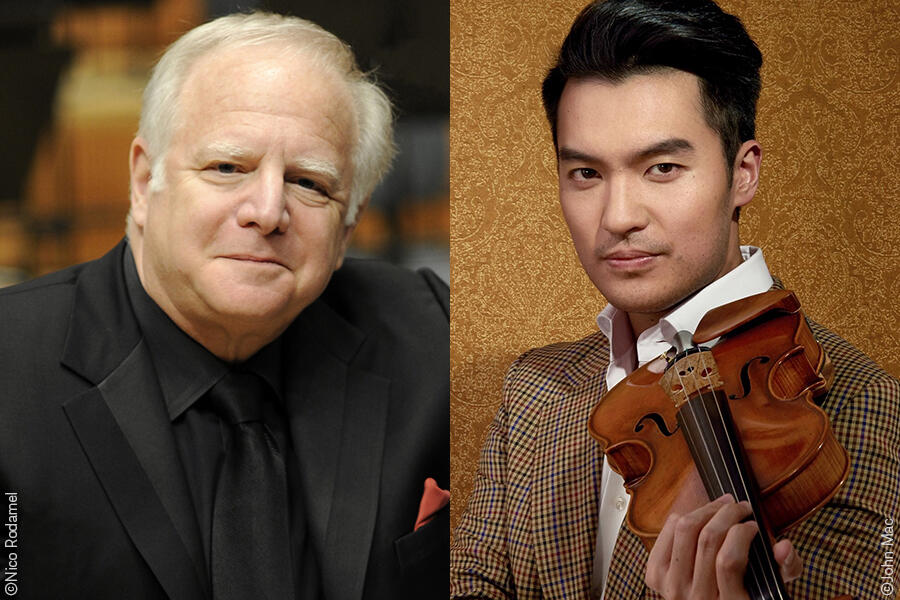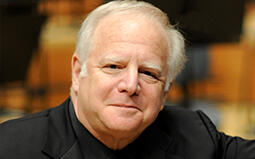- Home
- Concerts
- Subscription Concerts 2022-2023
- Program B
- No. 1970 Subscription (Program B)
No. 1970 Subscription (Program B)
The 150th Anniversary of Vaughan Williams's Birth
Suntory Hall
Google Map Seating Chart

Program
Vaughan Williams / Five Variants of Dives and Lazarus
Born in South England, Vaughan Williams (hereafter VW) had a distinctive "English" style firstly because he collected/edited English folksongs and carols of which he used many in his own compositions.
The uniqueness of Five Variants of Dives and Lazarus (1939) resides in its concept, as this is a series of "variants" but not "variations". In the oral tradition, one single folksong has diverse variants (versions) with slightly different music and/or words. Here VW joined a folksong and its variants to freely orchestrate them. The melody of Dives and Lazarus has been known in England since the 16th century at least. The lyrics are based on the parable of Jesus from the Gospel of Luke about a rich man who refuses to give alms to a beggar.
Despite a small ensemble for strings and harp, the work sounds thick (for each section is often subdivided) but also transparent thanks to VW’s exceptional orchestration inherited from his teacher Ravel. The introduction where the original tune is given and the five variants are played seamlessly, but the start of each is noticeable with the change of atmospheres and times. The most recognizable is the Variant III as it's opened by the violin solo over harp accompaniment. The Variant V in 4/4 time evokes a solemn chorale. After the powerful climax, a tranquil moment comes to end this beautiful piece which was unsurprisingly played at the composer's funeral.
[Kumiko Nishi]
Mendelssohn / Violin Concerto E Minor Op. 64
Born in Germany, Mendelssohn wore many hats: as a gifted composer, an excellent pianist, an inspirational conductor—he led the prestigious Gewandhausorchester Leipzig—and an indefatigable educator who founded the Leipzig Conservatory. He was also a leader of the “revival” of J. S. Bach’s works.
It is no exaggeration to say that Op. 64 is the most popular violin concerto. Mendelssohn wrote it for Ferdinand David, a violinist who was then concertmaster of the Gewandhausorchester, taking advice from him. The premiere took place in 1845, two years earlier than the composer’s demise at age 38.
All the three movements are played without pause, which was exceptional during the time. Mendelssohn fills the concerto with Romantic virtuosity while following Classical concerto format in a free manner. The opening sonata movement has an introduction less than two bars before the violin solo enters singing the—world-famous—flowing, fervent first theme. The G-major second theme introduced by woodwinds has a calmer character. Here the composer wrote down the soloist’s cadenza (virtuosic improvisatory section) in full, which was, again, an atypical thing in those days. Following a sustained note by bassoon as a bridge, the next slow movement in C major starts. It has a symmetric A–B–A form with the unquiet central section. The final movement has a minor short prelude by strings before a bright trumpet fanfare announces the beginning of the E-major Allegro section in sonata rondo form. Then the solo violin gives immediately the bouncing main theme. The soloist and the orchestra both dash for the feverish, festive ending.
[Kumiko Nishi]
Vaughan Williams / Symphony No. 5 D Major
Trained in London and later by Bruch and Ravel on the continent, VW was a prolific composer who pursued a wide range of genres. However, his role as a great symphonist was particularly essential for 20th century music history, as most of his contemporaries turned their back on the tradition of symphony anchored by Bruckner and Mahler.
VW left us nine symphonies premiered between 1910 and 1958. Interestingly enough, the Fifth is "dedicated without permission to Jean Sibelius" (VW's own expression), another great symphonist of the century whom VW esteemed. Of all nine, the Fifth is the most serene symphony. This character is somewhat unexpected considering its historical backdrop, as it was composed mostly during World War II. Conceivably, an undertone of darkness in this idyllic music might be tied to this unpeaceful time. We should also consider that numbers of this symphony’s main materials are quoted from his then-uncompleted opera The Pilgrim’s Progress based on a Christian allegory written by the Puritan preacher John Bunyan. VW had been working on this opera since the pre-war period.
The Fifth consists of four movements. VW first brings the home key into question, as the opening movement in flexible sonata form begins dissonantly with a horn dotted call in D major against a C note sustained by low strings. Then the violins doubled by flutes introduce the folksy, slightly dark main tune in D major, before the radiant second theme is given by violins in E major. The next movement is a rhythmically inventive scherzo. The third movement begins with strings utilizing mutes, a devise to make a softer sound, and a lone cor anglais (English horn) solo. Soon after, violas lead a contrapuntal string ensemble followed by an extensive, intense musical meditation. In the last movement, VW modernizes the past passacaglia form, a series of variations over a repetitive bass melody. This luxuriant finale reminds us of how deeply VW is rooted in the 16th–17th century's polyphonic tradition of England. The symphony has a celestial conclusion in D major as though it answered the opening question.
[Kumiko Nishi]
Artists
 ConductorLeonard Slatkin
ConductorLeonard Slatkin
One of the world's leading conductors, Leonard Slatkin was born in Los Angeles in 1944 to a musical family. His father Felix Slatkin was a renowned conductor and violinist, and founder of the Hollywood String Quartet, and his mother was a cellist of the quartet. He studied conducting under Jean-Paul Morel at the Juilliard School. From 1979 to 1996, he served as Music Director of the St. Louis Symphony Orchestra, and significantly improved the orchestra’s performance quality while making a great number of recordings. Then he was Music Director of the National Symphony Orchestra from 1996 to 2008, and from 2000 to 2004 he also served as Chief Conductor of the BBC Symphony Orchestra. In 2008, he was appointed Music Director of the Detroit Symphony Orchestra, and for over a decade, he contributed to the development of the orchestra (now Music Director Laureate), and from 2011 to 2017, he made a great achievement as Music Director of the Orchestre national de Lyon (now Honorary Music Director). He has made innumerable guest appearances with the world's most prestigious orchestras, and with the NHK Symphony Orchestra, he has made a return every few years since his first appearance in 1984, forging a close and trusting relationship.
The music he creates has both bright and dynamic expansion and meticulous detail, and surely such fine quality will be fully displayed in the works of Vaughan Williams and Copland which he has been especially noted for. The coming subscription concerts under his baton will be no doubt a good opportunity to highlight the authentic value of such works which are rarely performed in Japan.
[Motoyuki Teranishi, music critic]
 ViolinRay Chen
ViolinRay Chen
Born in Taiwan and growing up in Australia, Ray Chen was admitted to the Curtis Institute of Music in Philadelphia when he was fifteen, to study under Aaron Rosand. He won the Yehudi Menuhin International Competition in 2008 and the Queen Elisabeth International Music Competition of Belgium in 2009, and garnered the world's attention. He was introduced as an artist worth attention in Strad and Gramophone, both major music magazines in Europe, and was selected as one of 30 most influential Asians under 30 years old in Forbes Magazine. After winning international competitions, he has worked with the world’s famed orchestras including the London Symphony Orchestra, the Leipzig Gewandhaus Orchestra and the Los Angeles Philharmonic with conductors such as Riccardo Chailly, Vladimir Jurowski, and Sakari Oramo.
He currently plays a 1714 Stradivarius ‘Dolphin’ on loan from the Nippon Music Foundation.
[Takuya Katagiri, music critic]
Ticket
Program B
No. 1970 Subscription (Program B)
Suntory Hall
Google Map
Seating Chart
Single Tickets Release Date
Pre-sales for Subscribers:Thursday, August 4, 2022
*about subscribers
Sale to General Public:Sunday, August 7, 2022
Price
| S | A | B | C | D | |
|---|---|---|---|---|---|
| Ordinary Ticket | 8,900 | 7,400 | 5,800 | 4,700 | 3,700 |
| Youth Ticket | 4,000 | 3,500 | 2,800 | 2,100 | 1,500 |
Seating chart Enlarge Print PDF
*tax included
*About Youth tickets (Available at N-Kyo Guide)
*Subscribers receive a 10% discount (Available at NHKSO WEB Ticket and N-Kyo Guide)
*For wheelchair-accessible seats, please refer to the N-Kyo Guide
Starting Dates of Ticket Sales
ANNUAL SUBSCRIPTION TICKETS Mon., July 18, 2022 11:00am
[For Subscribers: Thu., July 14, 2022 11:00am]
Youth Tickets
Youth Tickets are great options for those of 25 years old and younger
WEB Select 3 Plus
Choose three or more of your favorite concerts and get a discount on single tickets
*Only available at NHKSO WEB Ticket NHKSO WEB Ticket (Accesible from Japan only)
For further information and subscription application
N-Kyo Guide TEL:0570-02-9502
Broadcast
 NHK Educational TVClassical Concert Hall
NHK Educational TVClassical Concert Hall
No. 1970 Subscription (Program B)
Sunday, Jan 22, 2023 9:00PM - 11:00PM
Program:
Vaughan Williams / Five Variants of Dives and Lazarus
Mendelssohn / Violin Concerto E Minor Op. 64
Vaughan Williams / Symphony No. 5 D Major
Conductor:Leonard Slatkin
Violin:Ray Chen
Recorded:November 23, 2022 Suntory Hall
To watch a concert,
(accessible only from inside Japan)
(accessible only from inside Japan)

